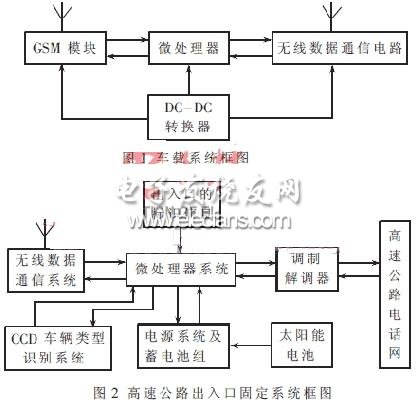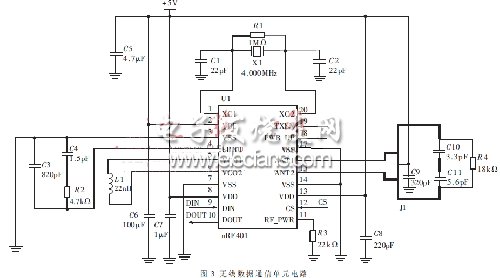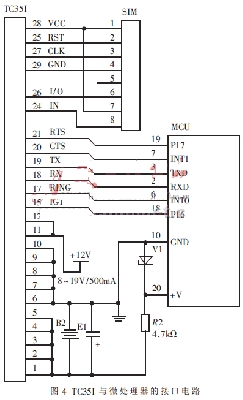The GSM communication network has become very popular and has basically achieved seamless coverage in China. The GSM wireless network system operates reliably, and its encryption technology is very mature. The GSM network dedicated module TC35I, Bluetooth wireless data communication chip nRF401 and microprocessor were used for comprehensive development, and the preliminary design and experiment of the intelligent toll system without highway toll station and free parking verification were completed.
1 Working principle of the system
The system is mainly composed of two parts: one is the vehicle-mounted system, its structural block diagram is shown in Figure 1; the second is the fixed base station and exit base station system at the entrance of the highway, and its structural block diagram is shown in Figure 2.

1.1 On-board system
The vehicle-mounted system is composed of a GSM network dedicated module TC35I with the function of sending and receiving short messages, a single-chip microcomputer control system and a wireless data communication circuit based on Bluetooth technology. The microprocessor connects with the GSM module TC35I at a rate of 19.2kb / s through the circuit, calls the mobile phone's international mobile identification code and mobile phone number, and automatically fills in the identification information. The communication distance of the wireless data communication circuit is greater than 100 meters. When the vehicle passes the highway entrance and exit at a speed of 40km / h, it is guaranteed to complete the identity verification and toll communication within 1 to 3 seconds.
The MCU control system enters the standby state after being powered on and initialized, and the wireless data communication is in the receiving state. After receiving the instruction from the base station, the received information is analyzed. If it is a highway entrance, the entrance information and toll number are stored in the internal EEPROM, and the encrypted identification information is issued; if it is an exit, the entrance related information and identification information are sent to the exit base station together, and the exit base station collects The information received is verified one by one, and the verification result and charging information are returned. Finally received the toll message from the toll center commissioned by the highway management system through the GSM network. After the system completes the data exchange, the wireless data communication circuit enters a short sleep state and stays for five minutes to avoid repeatedly receiving entrance information or affecting the subsequent vehicle's wireless communication.
1.2 Freeway entrance and exit fixing system
The fixed system is divided into an egress base station and an ingress base station. The physical structure is basically the same and the functions are different. In the entrance part, first verify the model of the vehicle that will enter the highway through CCD to determine the toll price; then issue a command through the wireless data communication system to verify whether the vehicle has an automatic payment system. After receiving the response from the in-vehicle system and confirming that the car has an automatic payment function, the vehicle's feature information, "identity" verification information and the automatic charge number of the car will be notified to each outlet through the modem and fixed telephone network. System; At the same time, it is transmitted to the vehicle-mounted system through wireless data communication for verification when outbound. After the vehicle is released, verify whether the vehicle has the ability to pay through the telephone network. If a car does not have the ability to automatically pay or owe payment, the wireless system at each intersection will track the whereabouts of the car and promptly feed back the information to each duty station to force the charge by the duty staff.
The fixed base station system of each exit first detects the arrival of a car through the CCD. When it reaches the effective range of wireless communication, the wireless communication system is activated. After receiving the entrance information, charge number, vehicle type and identification information of the car, the entrance system Compare the information transmitted through the wired network, if everything is normal, then open the threshold, let pass, notify the toll center to charge and send toll SMS. The content of the charged SMS includes information such as date, model, entrance and time, exit and time, and total distance. On the contrary, it must be charged by on-duty personnel and released by manual operation.
2 Main component selection and interface circuit design
2.1 Wireless data communication circuit
The wireless data communication circuit is mainly responsible for the short-range wireless data exchange task between the motor vehicle and the fixed base station system. It is composed of core chip nRF401 and its accessory components. nRF401 is a dual-channel, high-performance, low-power dedicated wireless communication chip. The operating frequency is 433.93 / 434.33MHz, the operating voltage is 3.3V, and the maximum communication rate is 20kbps. It can be directly connected to the serial port of the single-chip microcomputer for asynchronous communication to achieve Data is sent and received without encoding the data. The data input terminal DIN is connected to the TXD terminal of the single chip microcomputer, and the data output terminal DOUT is connected to the RXD terminal of the single chip microcomputer. In this circuit, the communication rate is designed to be 19.2kbps. The circuit principle is shown in Figure 3.

2.2 GSM communication module
GSM communication module adopts TC35I of SIEMENS. TC35I is a special module designed by SIEMENS for GSM communication. It has voice, data, fax and point-to-point SMS functions. It works in the EGSM 900 and GSM 1800 frequency bands, weighs only 10g, and works normally in the range of 3.5 ~ 4.8V The main commands defined by AT Commands Interface Version 8.5 can be well executed, and there are more than 20 extended commands.
The TC35I interface consists of a 40-core cable, of which pins 1 to 5 are connected to the "+" end of the battery, pins 6 to 10 are connected to the "-" end of the battery, and pins 11 to 12 are DC power input terminals, which can input 8 to 20V / 500mA The DC power supply has an internal charging control circuit. The 15-pin IGT is the module power-on control, and the 31-pin EMERGOFF is the power-off control. They are all low-level effective, and can also be turned on and off by command. Pin 17 is ringing output, pin 18 RX is serial data output, pin 19 TX is serial data input, pin 32 is the working status indicator output, and pins 24-29 are connected to the SIM card. The interface circuit with the microprocessor is shown in Figure 4. The communication rate is 19.2kbps.

All instructions of TC35I can be downloaded from SIEMENS website.
2.3 CPU control circuit
The mobile payment system for vehicle users consists of a low-cost AT89C4051 single-chip microcomputer, with a working power supply of 3.3V. The base station consists of a high-speed and high-performance 77E58-40 single-chip microcomputer for wireless data communication and identity verification. CCD model recognition is performed by another independent processing unit.
5G Industrial Router features Application field
With the continuous progress and development of science and technology, a new generation of communication technology -5G is gradually entering our lives. In the industrial field, the application of 5G technology is also constantly advancing, bringing new opportunities and challenges to industrial production. Industrial routers, as one of the key devices for 5G applications, play a crucial role. This paper will introduce the definition, characteristics, application fields, development trends and other aspects of 5G industrial routers in detail.
What is 5G Industrial Router
Simply put, 5G industrial router is a special type of router equipment based on 5G technology, which is used to connect industrial equipment and systems to achieve high-speed transmission and exchange of data. Compared with traditional routers, 5G industrial routers have higher bandwidth and lower latency, which can better meet the requirements of real-time data transmission and high stability in industrial production environments.
Features of 5G industrial routers
First of all, high bandwidth is a significant feature of 5G industrial routers. The introduction of 5G technology enables industrial routers to support large-scale data transmission and processing, providing more powerful data communication capabilities for modern industrial production. Second, low latency is another important feature of 5G industrial routers. The advantage of low latency enables industrial routers to achieve real-time data transmission and processing, improving the efficiency and response speed of industrial production. In addition, 5G industrial routers also have the characteristics of high stability, high reliability and high security, and can cope with complex industrial environments and demanding data communication needs.
5G industrial router application field
First of all, the Internet of Things field is one of the important areas of 5G industrial router application. As the popularity and application range of Internet of Things devices continue to expand, the requirements for data communication are becoming higher and higher, and 5G industrial routers can provide reliable data connection and transmission services for Internet of Things devices. Secondly, the field of industrial automation is also one of the main application areas of 5G industrial routers. In industrial production, the transmission and processing of real-time data is crucial to improve production efficiency and quality, and 5G industrial routers can meet the needs of high-speed and low-latency data transmission to help achieve the goal of industrial automation. In addition, 5G industrial routers can also be widely used in intelligent transportation, smart cities, intelligent manufacturing and other fields.
With the continuous development of 5G technology, 5G industrial routers will also usher in a new development trend. First, with the popularity of iot devices, the demand for 5G industrial routers will further grow. Secondly, the introduction of virtualization and network slicing technology makes industrial routers have higher flexibility and scalability, in addition, the improvement of security will also become an important direction of the development of 5G industrial routers to cope with increasingly complex network threats and security challenges.
5G Industrial Router,Industrial Lte Router Poe,Industrial Security Router,Industrial 5G Cellular Router
Shenzhen MovingComm Technology Co., Ltd. , https://www.szmovingcomm.com